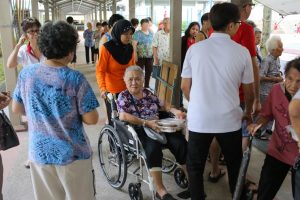Tuning care relations between migrant caregivers and the elderly in Singapore
May 10, 2022

In the face of rapidly ageing population, Singapore has become highly dependent on foreign domestic workers to provide home-based care for the elderly. Popular perception of the relationship between migrant caregivers and elderly care recipients is polarised. While some media reports have highlighted acts of abuse and even murder of the elderly by migrant caregivers, non-governmental organisations have emphasised the precarity and exploitation of foreign domestic workers by their employers.
In ‘Tuning care relations between migrant caregivers and the elderly in Singapore’(Asia Pacific Viewpoint, 2020), Research Associate Jian An Liew (NUS Asia Research Institute), Professor Brenda S.A. Yeoh (NUS Department of Geography and Asia Research Institute), Associate Professor Shirlena Huang (NUS Department of Geography), and Associate Professor Elaine Lynne-Ee Ho (NUS Department of Geography) sought to develop a more nuanced understanding of the interactions between migrant caregivers and elderly care recipients beyond sensational, victim-driven portrayals of care relations. They assert that a more accurate depiction is that the caregiver and recipient are in a mutual and reciprocal process undergoing constant ‘tuning’ on an everyday basis, where parties are ‘mutually tuned in’ when they have cultivated reciprocally meaningful relationships.
The authors conducted semi-structured, in-depth interviews with 69 Singaporean seniors and 35 migrant caregivers employed for eldercare in Singapore, analysing the results under Alfred Schütz’s intersubjective ‘tuning’ framework. Three components of the ‘tuning’ framework were employed in the study. First, people inhabit both ‘objective time’ (quantified by objective measurement) and ‘subjective time’ (time consciously experienced). Second, ‘true face-to-face’ interactions are important to build social relations. Third, there is a distinction between ‘in-order-to motives’ (the expected goals of planned actions) and ‘because motives’ (cause(s) of action attributed retrospectively).
The authors then zoomed in on three dyads of elderly-caregiver as case studies, showing that although care dyads co-exist at the same time and space, their relationship oscillates between ‘tuning out’ and ‘tuning in’ in their daily activities. Attunement can be initiated by either the caregiver or the recipient. Spatial and temporal proximity between the two enables either party to anticipate the counterparty’s needs and fulfil them more efficiently (‘tuned in’). However, proximity can also heighten the elderly’s certain expectations of the caregiver. Additionally, the synchronicity of care dyads depends heavily on the compatibility between the pair’s ‘in-order-to motives’ and ‘because motives’ in relation to intended actions. The elderly-caregiver relationship is not pre-defined or dictated by either party. Rather, it requires constant fine-tuning for (re)calibration in daily interactions.
Practically, a harmonious elderly-caregiver relationship (a ‘genuine mutual tuning-in relationship’) requires both parties to be willing to extend care and show empathetic attitudes towards each other and to adopt certain ‘good practices’, e.g., sharing meals and avoiding heavy-handed control. Greater attention should also be paid to elderly care recipients as compared to that given to caregivers.
Read the article here: https://onlinelibrary.wiley.com/doi/abs/10.1111/apv.12259
